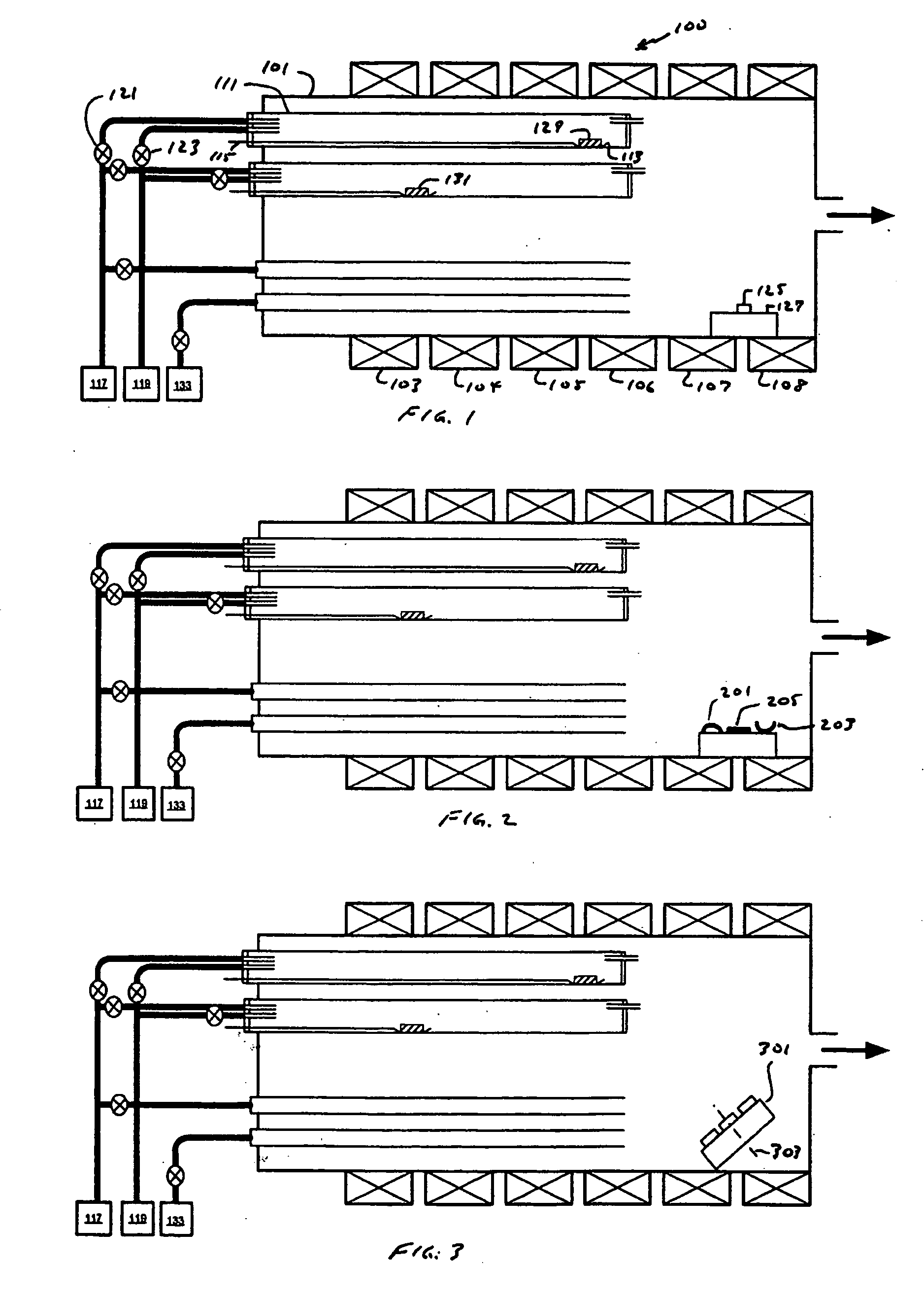Method and apparatus for fabricating crack-free group III nitride semiconductor materials
a technology of nitride and semiconductor materials, applied in the field of semiconductor materials, can solve the problems of limiting their performance as well as their commercial viability, their tendency to crack, and even forming cracks on the substra
- Summary
- Abstract
- Description
- Claims
- Application Information
AI Technical Summary
Problems solved by technology
Method used
Image
Examples
embodiments
Embodiment 1—AlN Material Growth and Wafer Preparation
[0066] The growth of AlN material by the inventive process was performed in an inert gas flow at atmospheric pressure in a hot-wall, horizontal reactor chamber. SiC substrates were placed on a quartz pedestal and loaded into the growth zone of the quartz reactor. The growth was performed on the (0001)Si on-axis 6H-SiC substrate, the substrates having a surface rms roughness of approximately 0.3 nm or better.
[0067] Approximately 1 pound of Al metal (5N) was placed in a sapphire source boat for use in growing the AlN thick layer. For extended runs, typically those requiring a growth cycle of more than 48 hours, multiple Al sources / boats were used, either in parallel or sequentially. The source boat was placed in a quartz source tube (i.e., source channel) within the source zone of the reactor. This source tube (or tubes when multiple Al sources were used) supplied AlCl3 to the growth zone of the reactor. Additional quartz tubes (...
embodiment 2
Growth and Wafer Preparation
[0072] Using a modified HVPE process, a 400 micron thick AlN boule was grown on a 2 inch SiC substrate at a growth temperature of 900° C. and at a growth rate of 30 microns per hour. The AlN boule was grown in the growth sub-zone yielding substantially flat layer growth. After completion of the growth cycle, the SiC substrate was removed by a combination of chemical etching, RIE and mechanical polishing. The resultant AlN wafer was polished, etched and cleaned and then re-introduced into the flat growth sub-zone of the HVPE reactor. A 1 centimeter thick AlN boule was grown on the (0001)N face of the prepared AlN seed wafer, the resultant boule being crack-free.
[0073] The AlN boule was sliced into 8, 2-inch AlN wafers with thicknesses ranging from 200 to 500 microns. X-ray diffraction studies showed that the AlN wafers had a single crystal structure (e.g., the FWHM of the x-ray RC was less than 300 arc sec).
[0074] The AlN wafers were subjected to chemica...
embodiment 3
abrication
[0075] The growth of AlN material by the inventive process was performed in an inert gas flow at atmospheric pressure in a hot-wall, horizontal reactor chamber. Two inch SiC substrates were placed on a quartz pedestal and loaded into the growth zone of the quartz reactor, positioned for AlN deposition on the (0001)Si on-axis surface.
[0076] Approximately 1 kilogram of Al metal was placed in the source boat. After purging the reactor with Ar gas, the growth zone and the Al source zone were heated to 920° C. and 750° C., respectively. To prepare the substrates for AlN deposition, HCl gas was introduced into the growth zone to etch the SiC substrates. The HCl gas was then introduced into the Al source zone, thereby forming aluminum chloride that was transported into the growth zone by the Ar carrier gas. Simultaneously, NH3 gas was introduced into the growth zone, the NH3 gas providing a source of nitrogen. As a result of the reaction between the aluminum chloride and the NH3...
PUM
| Property | Measurement | Unit |
|---|---|---|
| thickness | aaaaa | aaaaa |
| thickness | aaaaa | aaaaa |
| thickness | aaaaa | aaaaa |
Abstract
Description
Claims
Application Information
 Login to View More
Login to View More - R&D
- Intellectual Property
- Life Sciences
- Materials
- Tech Scout
- Unparalleled Data Quality
- Higher Quality Content
- 60% Fewer Hallucinations
Browse by: Latest US Patents, China's latest patents, Technical Efficacy Thesaurus, Application Domain, Technology Topic, Popular Technical Reports.
© 2025 PatSnap. All rights reserved.Legal|Privacy policy|Modern Slavery Act Transparency Statement|Sitemap|About US| Contact US: help@patsnap.com


